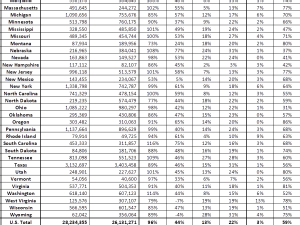US diesel demand flat as freight growth slows
By: Reuters | Oct 29 2015 at 04:35 PM | Intermodal
U.S. diesel consumption has been flat this year after growing strongly in 2013 and 2014, mirroring a slowdown in inland freight movements and the worldwide slowdown in the raw materials sector.
Diesel consumption measured by the Energy Information Administration’s data on distillate supplied is closely correlated with freight movements measured by the Bureau of Transportation Statistics’ transportation services index.
The freight transportation services index measures freight movements by road, rail, barge, pipeline and aircraft in ton-miles.
Distillate consumption is highly geared to the freight transport sector. Two-thirds of distillate is consumed as diesel by trucks on the highways, with most of the rest used by railroads, farms, construction sites, oil companies and maritime firms.
Diesel demand has been more cyclical than gasoline, plunging during the recession of 2008/09, then rebounding more quickly in 2010/11 and 2013/14 .
Diesel consumption surged more than 200,000 barrels per day (bpd), almost 5.5 percent, in 2014, according to the EIA. By contrast, gasoline consumption rose by just 78,000 bpd, less than 1 percent.
But in 2015 the situation has reversed, with strong growth in gasoline demand and little or no increase in diesel consumption.
In the first seven months of the year, diesel was essentially flat compared with the same period in 2014, while gasoline demand rose by more than 250,000 bpd, almost 3 percent.
The slowdown in diesel appears directly linked to the slowdown in freight movements since the start of 2015 which is in turn linked at least in part to the ending of the energy boom.
The number of railcars moving coal and oil across the rail network has fallen sharply compared with 2014, according to weekly carload data from the Association of American Railroads (AAR).
The number of railcars transporting coal has fallen by more than 9 percent so far this year, while movements of oil and refined products are down more than 6 percent.
Movements of minerals, including sand and other aggregates used in oil production, have also slipped, according to AAR.
The slowdown in energy-related freight has dragged total railroad traffic down by more than 1 percent compared with 2014.
“From railroads to manufacturers to energy producers, businesses say they are facing a protracted slowdown in production, sales and employment that will spill into next year. Some of them say they are already experiencing a downturn,” the Wall Street Journal reported.
“Industrial companies are being buffeted on multiple fronts,” the Journal explained, but “much of the anticipated decline stems from the hard-hit energy industry” (“U.S. companies warn of slowing economy” Oct. 25).
Freight movements are being hit by the slowdown in key export markets, including China and Brazil, as well as the strength of the dollar.
The number of shipping containers being returned to Asia empty has been soaring in recent months confirming an export slowdown (“At U.S. ports, exports are coming up empty” Oct. 13).
Fewer exports mean fewer inland movements by road and railway to take products to the ports, cutting diesel consumption further.
More generally, the broad-based global slowdown in basic materials industries, from oil and coal to iron ore and copper, is washing back into the U.S. economy in the form of fewer movements of both raw materials and capital goods, which is in turn capping diesel demand. (Reuters)










